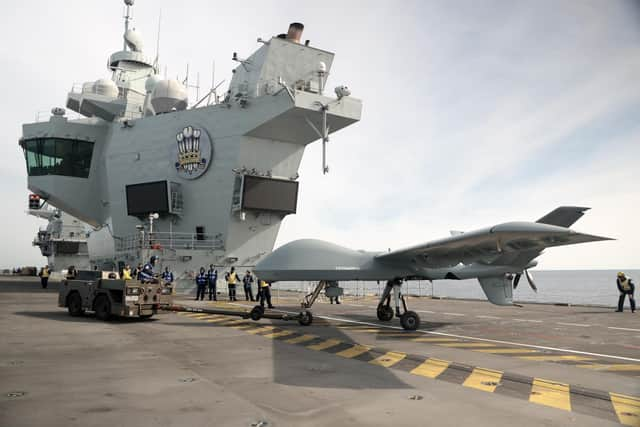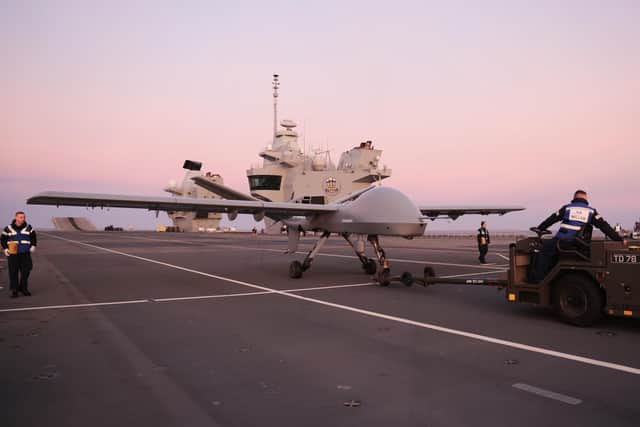HMS Prince of Wales: Crew on Royal Navy warship carry out ground-breaking crewless aircraft trial near USA
and live on Freeview channel 276
HMS Prince of Wales has been carrying out trials of unmanned aircraft – giving a glimpse in the future of warfare and naval operations. The largest un-crewed aircraft ever launched from the carrier’s flight deck was used in a variety of exercises.
Codenamed "Mojave”, the specially-modified aircraft was operated remotely by a ‘pilot’ at a computer terminal – taking off and landing on the ship off the east coast of the USA. No crewless machine its size has ever flown from a carrier outside the US Navy before.
Advertisement
Hide AdAdvertisement
Hide Ad

Mojave is nine metres long, weighs more than one and a half tonnes full loaded and has a wingspan of 17 metres, which is six metres wider than an F-35B Lightning stealth fighter. The trial near Virginia showcases the potential of how the Queen Elizabeth-class carrier can operate with un-crewed aircraft alongside crewed aircraft.
Rear Admiral James Parkin, Royal Navy Director Develop – whose team planned the trial – said: “The Mojave trial is a European first – the first time that a Remotely Piloted Air System of this size has operated to and from an aircraft carrier outside of the United States. The success of this trial heralds a new dawn in how we conduct maritime aviation and is another exciting step in the evolution of the Royal Navy’s carrier strike group into a mixed crewed and un-crewed fighting force.”
Vice Admiral Martin Connell, Royal Navy’s Second Sea Lord, said embracing autonomy was “the next logical step to ensuring that the Royal Navy can continue to fight and win in an increasingly-complex operating environment”. “With so many international partners interested in the results of these Mojave trials on board HMS Prince of Wales, I am delighted that we are taking the lead in such exciting and important work to unlock the longer-term potential of the aircraft carrier and push it deep into the 21st Century as a highly-potent striking capability,” he added.
The Royal Navy has operated un-crewed aircraft over the past two decades. Currently, the Fleet Air Arm’s existing systems are designed for short-range surveillance operations on land and at sea.
Advertisement
Hide AdAdvertisement
Hide Ad

Mojave is a version of the MQ1C Gray Eagle aircraft and has been adapted to short take-offs and landings from runways which are even smaller than the Queen Elizabeth-class carriers. Its a much more advanced aircraft than previous models and is capable of performing numerous long endurance missions from medium altitude.
Months of planning from HMS Prince of Wales’ crew, Royal Navy experts and General Atomics – the US company which built Mojave – went into the trial. Commander Martin Russell, in charge of air operations aboard the carrier, said: “My team and I are excited and proud to be the first to launch and land a Mojave from an aircraft carrier.
"During a deployment centred around experimentation and expanding the envelope of the Queen Elizabeth class, this is one of the highlights.” The carrier is due to sail home to Portsmouth next month following intense training and trials activity with the US Marine Corps.